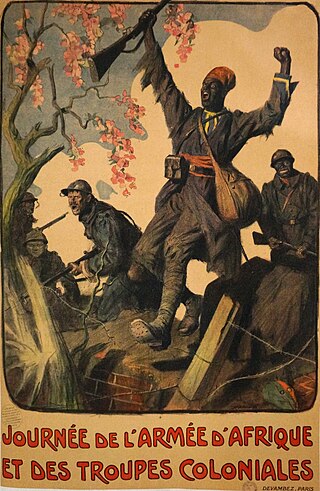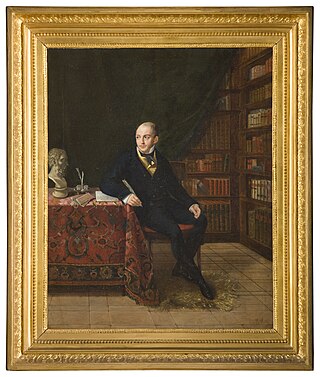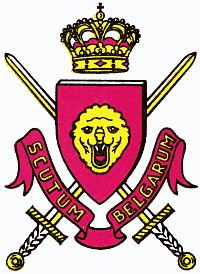
The Catholic University of Leuven or Louvain was founded in 1834 in Mechelen as the Catholic University of Belgium, and moved its seat to the town of Leuven in 1835, changing its name to Catholic University of Leuven. In 1968, it was split into two universities, the Katholieke Universiteit Leuven and the Université catholique de Louvain, following tensions between the Dutch and French-speaking student bodies.

The Army of Africa was an unofficial but commonly used term for those portions of the French Army stationed in French North Africa from 1830 until the end of the Algerian War in 1962, including the French units made up of indigenous recruits.
The 19th Army Corps was a corps of the French army. In December 1870, the Tours delegation created the 19th Army Corps which was formed in Alençon. It was recreated by decree of the JO of August 13, 1874, it brought together the various military units of Algeria. It constituted the nucleus of the Army of Africa.
The Walloon Movement is an umbrella term for all Belgium political movements that either assert the existence of a Walloon identity and of Wallonia and/or defend French culture and language within Belgium, either within the framework of the 1830 Deal or either defending the linguistic rights of French-speakers. The movement began as a defence of the primacy of French but later gained political and socio-economic objectives. In French, the terms wallingantisme and wallingants are also used to describe, sometimes pejoratively, the movement and its activists. To a lesser extent, the Walloon Movement is also associated with the representation of the small German-speaking population in the East Belgium of the Walloon Region.
Jean–François Tielemans was a Belgian lawyer and liberal politician. He was interim governor of the province of Antwerp from 7 April 1831 until 14 June 1831 and governor of Liège Province from 4 June 1831 until 4 October 1832.

Louis de Potter, was a Belgian journalist, revolutionary, politician and writer. Out of the more than 100 books and pamphlets, one of the most notable works was his famous Letter to my Fellow Citizens in which he promoted democracy, universal electoral rights and the unity among Belgian liberals and Catholics. As one of the heroes of the Belgian Revolution, he proclaimed the independence of Belgium from the Netherlands, and inaugurated the first Belgian parliamentary assembly, on behalf of the outgoing Belgian provisional government.
Léon Vanderkindere was a Belgian historian, academic and politician.

Several military units have been known as the Belgian Legion. The term "Belgian Legion" can refer to Belgian volunteers who served in the French Revolutionary Wars, Napoleonic Wars, Revolutions of 1848 and, more commonly, the Mexico Expedition of 1867.

The Tonkinese Rifles were a corps of Tonkinese light infantrymen raised in 1884 to support the operations of the Tonkin Expeditionary Corps. Led by French officers seconded from the marine infantry, Tonkinese riflemen fought in several engagements against the Chinese during the Sino-French War and took part in expeditions against Vietnamese insurgents during the subsequent French Pacification of Tonkin. The French also organized similar units of indigenous riflemen from Annam and Cambodia. All three categories of indigenous soldiers were known in Vietnam as Lính tập.

The Leuven Faculty of Theology was a branch of the Catholic University of Leuven, founded in 1834 in Mechelen by the bishops of Belgium as the Catholic University of Belgium, that moved its seat to the town of Leuven in 1835, changing its name to Catholic University of Leuven.
Henri Lambert (1862–1934) was a Belgian engineer and glass works owner at Charleroi near Brussels. His glass works was the largest in the world in that time. He was one of the first occupied with social economy. He spoke Walloon with his blue collar workers, which was exceptional in that time. He was a prolific writer of articles for newspaper and political journals, brochures, and books on political philosophy, and had several of his works translated into German and English. He favoured individualism, free trade, and international peace. He also wrote works about corporations, trade unions, government, democracy, and representation, voicing bold and well-intentioned ideas. But his criticism of the principle of limited liability in connection with corporations is an original point which seems to have attracted attention at the turn of the century, as well as his ideas about the organisation of trade unions. He was called upon to address lawyers' and economists' associations and other bodies.

The Tirailleurs indochinois were soldiers of several regiments of local ethnic Indochinese infantry organized as Tirailleurs by the French colonial authorities, initially in Vietnam from 15 March 1880. The most notable, and first established, of these units were the Tonkinese Rifles.

The Belgian Forces in Germany was the name of Belgium's army of occupation in West Germany after World War II. Lasting between 1946 and 2002, the army corps-strength FBA-BSD formed part of the NATO force guarding Western Europe against Warsaw Pact during the Cold War. At its height, 40,000 soldiers were serving with the unit with several thousand civilians also living in the Belgian zone around Cologne.
Lieutenant-General Baron Albert Crahay was a Belgian soldier and historian. He is known particularly as the commander of the Belgian contingent in the Korean War and of the Belgian army of occupation in Germany.
Jean-Baptiste de Bouge (1757–1833) was a Belgian cartographer whose career spanned decades of major political upheaval, his country in turn being the Austrian Netherlands, the United Belgian States, the French First Republic, the Napoleonic Empire, and the United Kingdom of the Netherlands, before becoming the Kingdom of Belgium. He often worked with the cartographic engraver Philippe Joseph Maillart.
Events in the year 1870 in Belgium.
Events in the year 1840 in Belgium.
Events in the year 1861 in Belgium.
Events in the year 1847 in Belgium.
Events in the year 1848 in Belgium.








